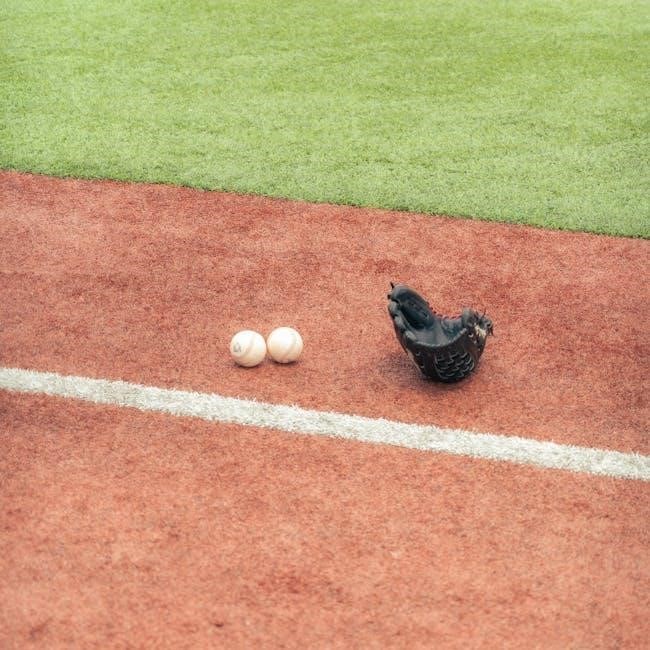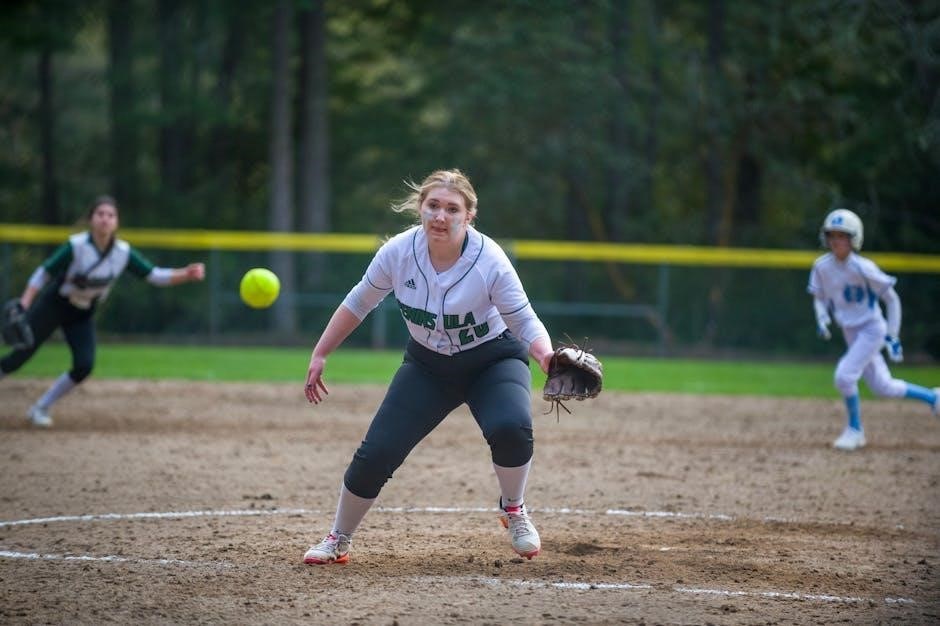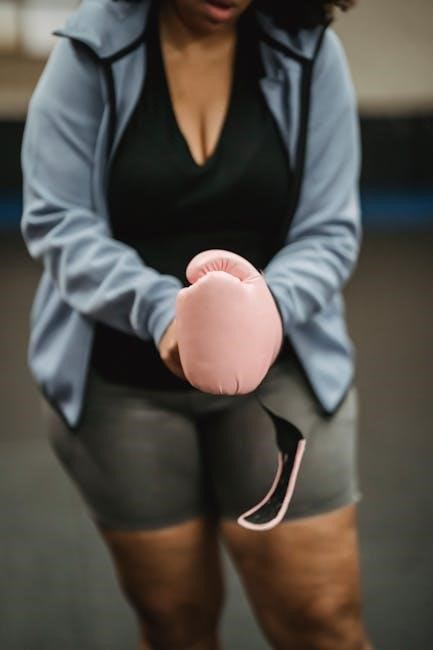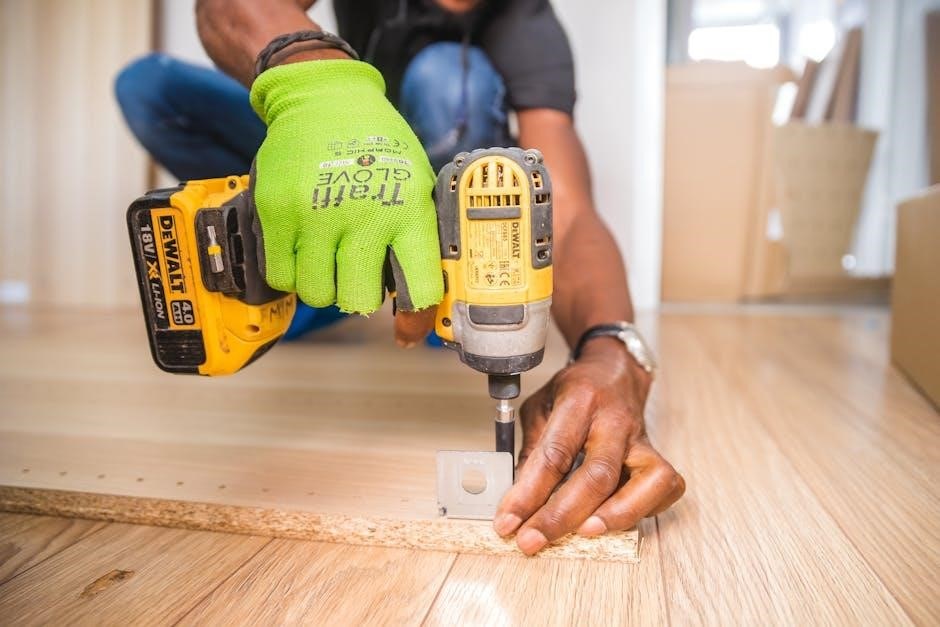A softball glove is an essential tool for players, offering protection, control, and precision; This guide helps you navigate sizing, materials, and proper fit to enhance performance and comfort.
Understanding the Importance of Proper Fit
A proper-fitting softball glove is crucial for optimal performance and comfort. A glove that is too tight may restrict movement, while one that is too loose can hinder control. Ensuring the right fit enhances grip, accuracy, and overall gameplay. Proper fit also prevents discomfort and potential injuries during play.
When trying on a glove, ensure it snugly wraps around your hand with enough room for your fingers to move freely. The wrist closure should provide support without feeling restrictive. A well-fitted glove allows for better control and precision, making it an essential factor in improving your skills on the field.
How to Choose the Right Glove Size
Choosing the right softball glove size involves considering your age, position, and hand size. Refer to sizing charts, which typically range from 11.5 to 14 inches for softball gloves. Infielders often prefer smaller gloves (11.75-12.5 inches) for quicker transfers, while outfielders opt for larger sizes (12.5-14 inches) to catch fly balls. Pitchers may prefer a closed-web glove between 11 and 12.5 inches for better control. First basemen require longer gloves (12-13 inches) to handle throws. Ensure the glove fits snugly but allows finger movement. Youth players should avoid oversized gloves to maintain control and precision. Proper sizing enhances performance and comfort during the game.

Key Factors in Selecting a Softball Glove
Position requirements, skill level, and personal preference are critical when choosing a softball glove. Ensure the glove aligns with your role, experience, and comfort needs for optimal performance.
Age and Skill Level Considerations
Age and skill level significantly influence softball glove selection. Youth players typically require smaller, lighter gloves for better control, while experienced players may prefer larger, more durable options. Beginners often benefit from synthetic materials for easier break-in, whereas advanced players might opt for high-quality leather for superior performance. Glove sizes for younger players usually range from 11.5 to 12 inches, while older, skilled players may use 12.5 to 13-inch gloves. Ensuring the glove matches both the player’s age and skill level ensures comfort and effectiveness on the field.
Position-Specific Requirements
Softball gloves vary by position, with specific designs catering to infielders, outfielders, pitchers, and catchers. Infielders typically use smaller gloves (11.5-12.5 inches) for quick ball transfer, while outfielders prefer larger gloves (12.5-14 inches) to catch fly balls. Pitchers often choose closed-web gloves for concealing pitches, and catchers require sturdy mitts with extra padding. First basemen need longer, flatter gloves for scooping throws. Each position demands a glove tailored to its unique demands, ensuring optimal performance and comfort during gameplay.
Hand Size and Glove Fit
Proper hand size and glove fit are crucial for comfort and performance. Measure your hand by stretching it flat, measuring from the base of the palm to the tip of the longest finger. Most adult gloves range from 11.5 to 13 inches, while youth sizes are smaller. Ensure the glove isn’t too tight or loose, allowing fingers to move freely. Adjustable wrist straps help customize the fit. A well-fitting glove should feel snug but not restrictive, enabling control and dexterity. Correct sizing ensures optimal performance and reduces the risk of discomfort or injury during play.
Level of Play: Recreational vs. Competitive
The level of play significantly influences glove selection. Recreational players may prioritize comfort and affordability, opting for synthetic materials that require minimal break-in. Competitive players, however, often prefer high-grade leather gloves for durability and superior performance. The frequency and intensity of games dictate the need for advanced features, such as tighter pockets and reinforced stitching. Understanding your play level helps tailor your choice to meet specific demands, ensuring optimal functionality and longevity. Balancing quality and budget is key, whether you’re playing casually or aiming for elite performance.

Softball Glove Sizing Chart
Refer to our softball glove sizing chart for age-specific, position-specific, and general size recommendations. It serves as a guide to help determine the right fit for you.
General Size Recommendations
Softball gloves typically range from 11.75 to 14 inches, with sizes varying by age and position. Players under 8 usually prefer 11.5-12 inches, while those aged 8-10 opt for 11.75-12.5 inches. Teens and adults often choose 12-13 inches, depending on their role. Outfielders may prefer larger gloves (12.5-14 inches) for deeper pockets, while infielders favor smaller sizes (11.75-12.5 inches) for quicker throws. Catchers and first basemen use mitts, which are slightly larger but differ in design. Proper fit ensures better performance and comfort, so it’s crucial to select a glove that aligns with your position and age group for optimal gameplay.
Position-Specific Size Guidelines
Softball gloves vary in size based on position, ensuring optimal performance. Infielders typically use smaller gloves (11.75-12.5 inches) for quicker transfers, while outfielders prefer larger sizes (12.5-14 inches) for deeper pockets. Pitchers often choose closed-web gloves (11-12.5 inches) to hide pitches. First basemen use longer, flared gloves (12-12.5 inches) for scooping throws. Catchers’ mitts are larger (12-12.5 inches) with extra padding for blocking. Position-specific sizing enhances fielding accuracy and player confidence, making it crucial to match glove size to your role on the field for improved gameplay and overall team performance.
Age-Specific Sizing Chart
Choosing the right glove size based on age ensures proper fit and control. For youth players under 8, gloves range from 11.5-11.75 inches, promoting ease of use. Ages 8-10 typically use 11.75-12 inches, balancing size and dexterity. Teenagers (11-13) often prefer 12-12.5 inches, offering more coverage. Adult players generally use 12.5-13 inches, providing durability and performance. Correct sizing by age ensures young athletes can handle the glove effectively, while adults maintain optimal functionality. Proper fit enhances skill development and game enjoyment for all age groups, making age-specific sizing a key factor in glove selection.

Materials and Construction
Softball gloves are crafted from durable materials like leather and synthetic fabrics. Leather offers a classic feel and longevity, while synthetic options provide affordability and easy break-in.
Leather vs. Synthetic Materials
When choosing a softball glove, the material is crucial for performance and durability. Leather gloves are preferred by experienced players due to their premium feel, durability, and ability to form a snug fit over time. They require a proper break-in period but offer long-lasting support and control. On the other hand, synthetic gloves are lightweight, easy to maintain, and ready for use right out of the box. They are ideal for younger players or those on a budget, though they may lack the longevity of leather options. Each material caters to different needs and preferences.
Webbing Styles and Their Effects
Webbing styles significantly impact a softball glove’s functionality and suitability for different positions. The most common designs include the H-web, I-web, and Closed web. The H-web offers a sturdy yet flexible structure, ideal for infielders who need quick ball transfer. The I-web provides excellent visibility and control, favored by outfielders. The Closed web is preferred by pitchers and third basemen, as it conceals the ball and offers extra support. Each webbing style caters to specific field positions and playing styles, ensuring optimal performance. Choosing the right webbing enhances both defensive skills and overall gameplay efficiency. Proper selection is vital for achieving peak performance.
Pocket Depth and Its Impact
Pocket depth in a softball glove plays a crucial role in catching and controlling the ball effectively. A shallower pocket allows infielders to transfer the ball quickly, while a deeper pocket suits outfielders needing to secure fly balls. Pitchers often prefer a slightly tighter pocket for better grip and concealment. The depth must align with the player’s position and style, ensuring comfort and performance. Proper pocket depth enhances control, reduces errors, and boosts confidence. Selecting the right depth is essential for optimal gameplay, as it directly impacts how the ball is caught and handled. A well-fitted pocket depth maximizes defensive capabilities and overall performance.

Fitting the Glove to Your Hand
Fitting the glove to your hand ensures optimal performance and comfort. Measure your hand precisely, consider the break-in process, and adjust for a snug, responsive fit.
Measuring Your Hand for the Best Fit
Measuring your hand accurately is crucial for selecting the right softball glove. Use a flexible tape measure to wrap around the knuckles, excluding the thumb, for an precise fit. Ensure the glove matches your hand size to prevent restrictive movement or excessive looseness. Proper measurement ensures optimal control and comfort during gameplay. This step is essential for both youth and adult players, as ill-fitting gloves can hinder performance. By taking the time to measure correctly, you can ensure a glove that feels tailor-made for your hand, enhancing your ability to catch, throw, and field effectively.
Ensuring Proper Break-In
Properly breaking in your softball glove is essential for optimal performance and comfort. Start by applying a leather conditioner to soften the material, then use a mallet to gently pound the palm and web areas. This loosens the leather and creates a natural pocket. Next, fold the glove in half and squeeze it firmly to enhance flexibility. Regularly working the glove with your hands helps shape it to your specific needs. Avoid extreme heat or force, as this can damage the leather. A well-broken-in glove ensures better control, a snug fit, and improved performance during games. Consistent care extends its lifespan.
Adjusting the Glove for Comfort
Adjusting your softball glove ensures a comfortable, personalized fit. Start by tightening or loosening the laces to secure your hand snugly. Ensure the fingers fit naturally without feeling cramped or too loose. The wrist strap should be adjusted to provide support without restricting movement. A well-adjusted glove enhances control and reduces discomfort during play. Test the fit by flexing your fingers and closing the glove to confirm ease of movement. Proper adjustments prevent blisters and improve grip, allowing you to focus on performance. Regularly check and tweak the fit as the glove breaks in further. A comfortable glove boosts confidence and overall playing experience.

Glove Maintenance and Care
Regular cleaning with mild soap and water keeps your glove fresh. Use leather conditioner to maintain softness and durability. Store in a cool, dry place to prevent cracking.
Cleaning and Conditioning
Proper cleaning and conditioning are crucial for extending the life of your softball glove. Start by gently wiping away dirt with a soft cloth. For deeper cleaning, use a mild soap solution, ensuring not to soak the leather. After cleaning, apply a leather conditioner to maintain moisture and prevent cracking. Avoid harsh chemicals or excessive water, as they can damage the material. Regular conditioning helps keep the glove supple and responsive, ensuring optimal performance season after season. By following these steps, you can preserve your glove’s quality and maintain its effectiveness on the field. Consistent care ensures longevity and reliability.
Storing the Glove Properly
Proper storage is essential to maintain your softball glove’s shape and quality. Store it in a cool, dry place away from direct sunlight to prevent cracking or fading. Avoid compressing the glove in tight spaces, as this can cause permanent creases. Use a breathable cloth or storage bag to protect it from dust. If storing for an extended period, lightly condition the leather to prevent drying out. Never store it while damp, as moisture can lead to mold or mildew. By storing your glove correctly, you ensure it remains in prime condition for future use, maintaining its performance and longevity.
When to Replace Your Glove
Knowing when to replace your softball glove is crucial for optimal performance. Signs include significant wear on the palm or fingers, a loose or detached web, and difficulty in maintaining the glove’s shape. If the leather cracks deeply or the padding wears thin, it’s time for a new glove. Additionally, if the glove no longer fits comfortably or requires frequent adjustments, it may be past its prime. Replacing your glove ensures better control, protection, and overall performance on the field. Regular inspections can help determine if a replacement is needed, preventing unexpected issues during games or practices.

Position-Specific Gloves
Softball gloves vary by position, with infielders needing smaller, quicker gloves and outfielders requiring larger mitts for fly balls. Pitchers and catchers have specialized designs for performance.
First Baseman Gloves
First baseman gloves, often called mitts, are designed for scooping and catching throws. They typically range from 12 to 12.5 inches, offering a deep pocket for secure catches. The padded palm and reinforced heel provide durability and impact absorption, essential for the high-traffic position. These gloves feature a shorter, more flexible design compared to other infield mitts, allowing for quick transitions and better control. They are crafted with a closed or partially closed web, enhancing the ability to handle hard throws and pick low balls. The size and structure ensure first basemen can perform their critical role effectively in the game.
Infield vs. Outfield Gloves
Infield and outfield gloves differ significantly in design and functionality. Infield gloves are smaller, typically ranging from 11.5 to 12.5 inches, with a shallower pocket for quick ball transfers and faster reactions. They feature shorter fingers and a more open web, allowing infielders to swiftly scoop and throw the ball. Outfield gloves, in contrast, are larger, usually between 12;5 and 14 inches, with a deeper pocket to securely catch high fly balls. They often have a longer, more padded design and a closed web for better control over long-distance catches. These distinctions ensure each position’s unique demands are met, optimizing performance and player comfort.
Catcher’s Mitt Specifics
Catcher’s mitts are uniquely designed for durability and protection, typically larger than other gloves, ranging from 32 to 35 inches in circumference. They feature extra padding and a reinforced palm to withstand high-speed pitches. The mitt’s design includes a claw-like shape to securely grip the ball, while the deep pocket helps absorb impact. Unlike other gloves, catchers’ mitts often have a more rigid structure to prevent the ball from popping out. Proper sizing is crucial for control and comfort, ensuring the mitt fits snugly around the hand. This specialized design makes it essential for catchers to choose a mitt that balances protection with mobility, optimizing performance behind the plate.
Youth vs. Adult Gloves
Youth gloves are smaller, designed for younger players, while adult gloves are larger, offering better control and durability. Both prioritize proper fit for optimal performance.
Differences in Size and Fit
Youth gloves are smaller, designed for younger players, while adult gloves are larger, offering better control and durability. Proper fit is crucial for performance and comfort.
Material Choices for Youth
For young players, synthetic materials are often preferred due to their lightweight nature and ease of break-in. These gloves are softer and require less maintenance, making them ideal for developing skills. Leather gloves, while durable, can be stiff for smaller hands. Synthetic options provide a more forgiving feel, allowing younger athletes to focus on technique without discomfort. Proper material selection ensures comfort and functionality, helping youth players perform at their best.
Helping Young Players Choose
Guiding young players in selecting the right glove involves balancing size, material, and comfort. Encourage them to try gloves on, ensuring a snug fit without restricting movement. Youth-specific models are designed with smaller hands in mind, offering better control. Emphasize the importance of proper break-in to ensure the glove feels natural during play. Additionally, consider their position and skill level to match the glove’s features. Providing clear, patient guidance helps build confidence and sets them up for success on the field.
Choosing the Right Glove for You
Selecting the perfect softball glove involves considering size, position, and material. Ensure proper fit and durability to enhance performance and comfort, tailored to your playing style and needs.
Top Brands and Their Features
Prominent brands like Wilson, Louisville Slugger, and Rawlings dominate the market with high-quality gloves. Wilson excels in durability and innovative designs, while Louisville Slugger offers classic styles with modern touches. Rawlings is known for its balanced blend of tradition and cutting-edge technology. Easton and Mizuno also provide exceptional options, catering to various playing styles and preferences. These brands often feature premium leather, customizable fits, and advanced webbing styles. Their gloves are crafted to meet the demands of both amateur and professional players, ensuring optimal performance and comfort. Each brand has its unique strengths, making them ideal choices for different needs.
Reading Reviews and Ratings
Reading reviews and ratings is crucial when selecting a softball glove. Player feedback offers insights into durability, comfort, and performance. Look for reviews from experienced athletes to gauge how a glove holds up over time. Pay attention to recurring themes, such as break-in ease or pocket depth. Ratings can highlight top-performing models, guiding your decision. However, consider multiple sources to avoid bias. Negative reviews can reveal potential drawbacks, helping you make an informed choice. Utilize this information to ensure your glove meets your specific needs and enhances your game performance effectively.
Trying Before Buying
Trying a glove before purchasing ensures proper fit and comfort. Visit stores to test different models, checking how the glove feels on your hand. Pay attention to finger length and wrist closure. If shopping online, consider retailers with flexible return policies. This allows you to assess the glove’s quality and fit without commitment. A well-fitting glove improves performance and reduces discomfort during games. Take your time to ensure it’s the right choice for your softball needs, enhancing both control and confidence on the field. This step is vital for maximizing your investment and ensuring satisfaction with your purchase.
Selecting the right softball glove involves understanding fit, material, and position needs. By following this guide, you’ll find a glove that enhances performance and comfort, ensuring success on the field.
Final Tips for Your Purchase
When purchasing a softball glove, ensure it fits comfortably and suits your position. Try it on both hands to confirm the best fit. Consider the break-in period and opt for pre-broken-in gloves if immediate comfort is needed. Evaluate the glove’s durability and material quality, as they impact performance and longevity. Read reviews and compare brands to find the best value for your skill level. Finally, visit a store to try the glove before buying, ensuring it feels right and meets your playing needs. A well-chosen glove enhances your game and provides lasting satisfaction.
Common Mistakes to Avoid
When selecting a softball glove, avoid guessing your size without proper measurement. Not considering your position can lead to a glove that’s too large or small. Ignoring material quality may result in reduced durability. Overlooking break-in time can cause discomfort during play. Buying a glove that’s too big for growth is a common error, as it hinders control. Failing to read reviews or compare brands can lead to poor value. Lastly, not trying the glove on before purchase risks an improper fit. These mistakes can affect performance, so careful consideration is essential for the best choice.
Frequently Asked Questions
Players often ask about replacing gloves, using baseball gloves for softball, and the best options for beginners. This section addresses these common queries clearly and concisely.
How Often Should I Replace My Glove?
The frequency of replacing a softball glove depends on usage and quality. High-end leather gloves can last 3-5 years, while synthetic gloves may need replacing after 1-2 seasons. Signs of wear, such as a losing shape or broken stitching, indicate it’s time for a new glove. Heavy-use players may need to replace theirs more frequently. Proper care can extend a glove’s lifespan. Ultimately, replace your glove when it no longer performs optimally or fits comfortably.
Can I Use a Baseball Glove for Softball?
While baseball and softball gloves share similarities, they are not interchangeable. Softball gloves are typically larger, with deeper pockets to accommodate the bigger ball. Baseball gloves have smaller, tighter pockets for better control of the smaller ball. Using a baseball glove for softball can lead to difficulty in catching and throwing, affecting performance. It’s recommended to use sport-specific gloves for optimal results. However, in a pinch, a baseball glove can be used, but it may not provide the best experience.
What’s the Best Glove for Beginners?
For beginners, choosing the right glove is crucial for comfort and performance. Opt for a glove with a smaller size and a simpler design, allowing easier control and maneuverability. Youth models or gloves made from synthetic materials are ideal as they are lighter and easier to break in. Proper fit is essential, ensuring the glove isn’t too tight or too loose. Consider consulting sizing charts and trying on gloves if possible. A well-fitting glove will help build confidence and improve skills. Prioritizing quality and comfort will enhance the learning experience for new players.

Leave a Reply